What Causes the Production Possibilities Curve to Shift Outward
two.2 The Production Possibilities Bend
Learning Objectives
- Explain the concept of the production possibilities curve and understand the implications of its downwardly gradient and bowed-out shape.
- Apply the production possibilities model to distinguish between full employment and situations of idle factors of product and between efficient and inefficient production.
- Empathise specialization and its relationship to the production possibilities model and comparative reward.
An economy's factors of production are scarce; they cannot produce an unlimited quantity of goods and services. A production possibilities curve is a graphical representation of the alternative combinations of goods and services an economic system tin produce. It illustrates the production possibilities model. In drawing the product possibilities curve, we shall assume that the economy can produce but ii appurtenances and that the quantities of factors of production and the technology available to the economy are stock-still.
Constructing a Production Possibilities Curve
To construct a production possibilities curve, we will begin with the case of a hypothetical firm, Tall Sports, Inc., a specialized sports equipment manufacturer. Christie Ryder began the business xv years ago with a single ski production facility virtually Killington ski resort in central Vermont. Ski sales grew, and she also saw need for snowboards rising—particularly after snowboard contest events were included in the 2002 Winter Olympics in Salt Lake City. She added a 2d establish in a nearby town. The 2d found, while smaller than the commencement, was designed to produce snowboards as well every bit skis. She also modified the beginning institute and then that it could produce both snowboards and skis. Two years subsequently she added a tertiary institute in another boondocks. While fifty-fifty smaller than the second plant, the 3rd was primarily designed for snowboard production just could also produce skis.
Nosotros can think of each of Ms. Ryder's three plants as a miniature economic system and analyze them using the product possibilities model. We assume that the factors of production and technology available to each of the plants operated by Alpine Sports are unchanged.
Suppose the first institute, Plant ane, tin produce 200 pairs of skis per month when it produces just skis. When devoted solely to snowboards, information technology produces 100 snowboards per calendar month. It tin can produce skis and snowboards simultaneously as well.
The table in Figure ii.2 "A Production Possibilities Curve" gives three combinations of skis and snowboards that Constitute 1 tin can produce each month. Combination A involves devoting the plant entirely to ski production; combination C means shifting all of the plant'south resource to snowboard production; combination B involves the product of both appurtenances. These values are plotted in a production possibilities curve for Found ane. The curve is a downwardly-sloping straight line, indicating that in that location is a linear, negative relationship between the production of the two goods.
Neither skis nor snowboards is an contained or a dependent variable in the product possibilities model; we can assign either one to the vertical or to the horizontal axis. Here, we have placed the number of pairs of skis produced per calendar month on the vertical axis and the number of snowboards produced per month on the horizontal axis.
The negative slope of the production possibilities curve reflects the scarcity of the constitute'southward capital and labor. Producing more snowboards requires shifting resource out of ski product and thus producing fewer skis. Producing more skis requires shifting resources out of snowboard production and thus producing fewer snowboards.
The slope of Establish 1'due south production possibilities curve measures the rate at which Tall Sports must give up ski product to produce additional snowboards. Because the production possibilities bend for Plant 1 is linear, we tin compute the slope between any two points on the curve and get the same result. Between points A and B, for case, the slope equals −2 pairs of skis/snowboard (equals −100 pairs of skis/50 snowboards). (Many students are helped when told to read this event as "−2 pairs of skis per snowboard.") Nosotros become the same value between points B and C, and betwixt points A and C.
Figure ii.ii A Production Possibilities Curve
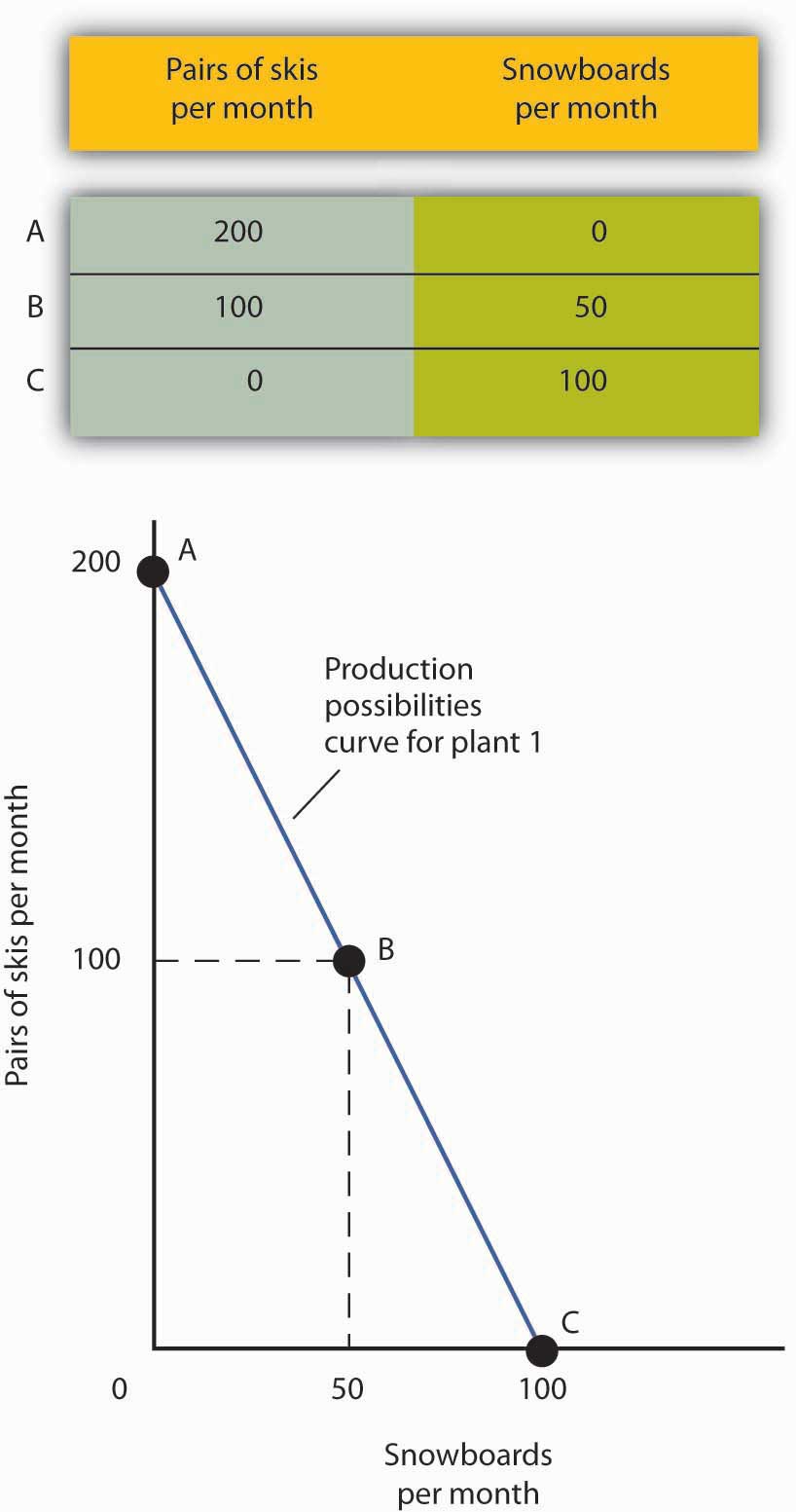
The table shows the combinations of pairs of skis and snowboards that Plant 1 is capable of producing each month. These are also illustrated with a product possibilities curve. Detect that this curve is linear.
To meet this relationship more clearly, examine Figure 2.3 "The Slope of a Product Possibilities Curve". Suppose Plant i is producing 100 pairs of skis and 50 snowboards per month at indicate B. Now consider what would happen if Ms. Ryder decided to produce i more snowboard per month. The segment of the bend effectually signal B is magnified in Figure 2.3 "The Gradient of a Production Possibilities Curve". The slope between points B and B′ is −2 pairs of skis/snowboard. Producing i additional snowboard at indicate B′ requires giving up 2 pairs of skis. Nosotros can think of this every bit the opportunity cost of producing an additional snowboard at Plant ane. This opportunity toll equals the absolute value of the gradient of the product possibilities curve.
Effigy ii.three The Slope of a Production Possibilities Curve
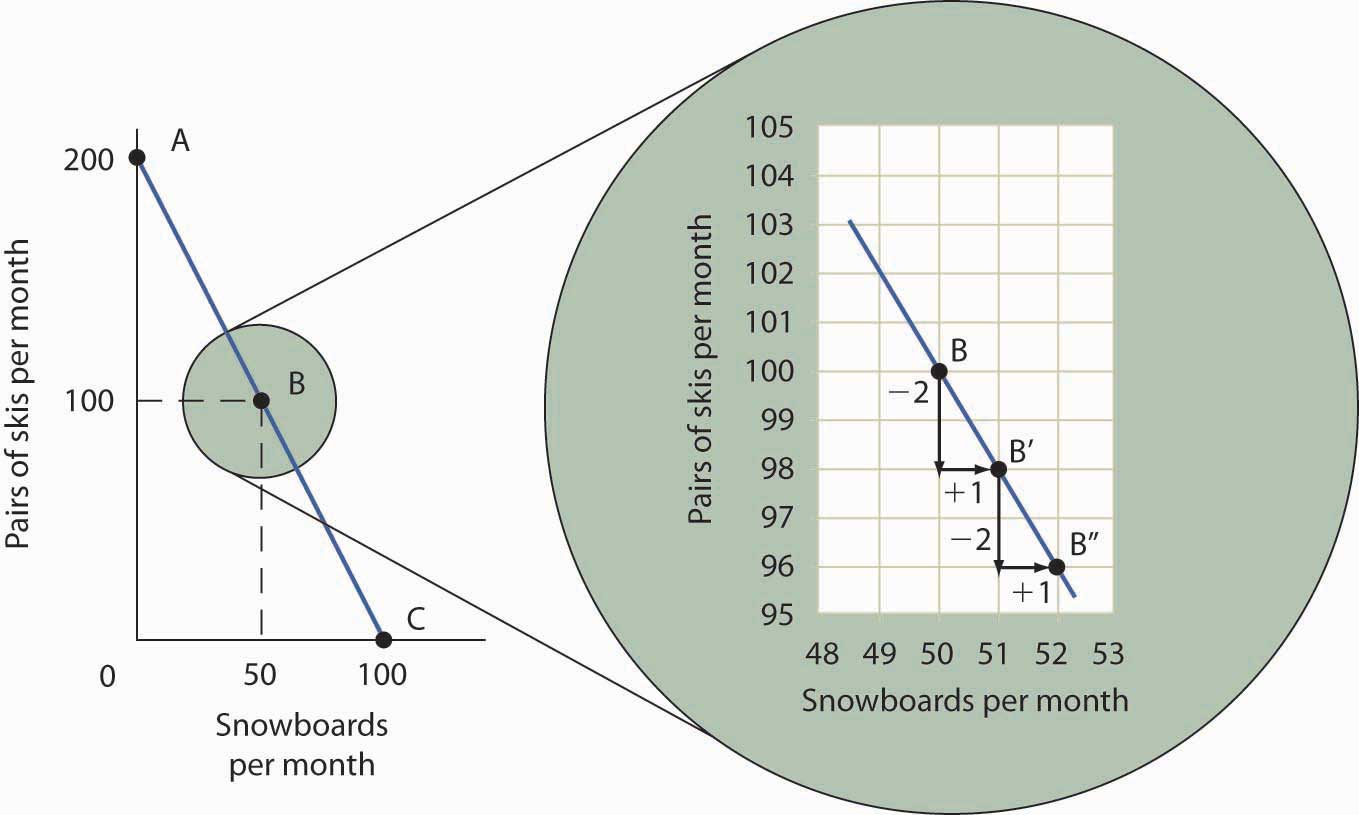
The slope of the linear production possibilities curve in Figure 2.ii "A Production Possibilities Curve" is abiding; it is −2 pairs of skis/snowboard. In the section of the curve shown here, the gradient can exist calculated betwixt points B and B′. Expanding snowboard product to 51 snowboards per month from 50 snowboards per calendar month requires a reduction in ski production to 98 pairs of skis per month from 100 pairs. The slope equals −two pairs of skis/snowboard (that is, information technology must give up ii pairs of skis to free up the resources necessary to produce i boosted snowboard). To shift from B′ to B″, Tall Sports must give upwardly two more than pairs of skis per snowboard. The absolute value of the slope of a production possibilities curve measures the opportunity cost of an additional unit of the good on the horizontal axis measured in terms of the quantity of the good on the vertical axis that must exist forgone.
The absolute value of the slope of whatever product possibilities bend equals the opportunity cost of an additional unit of the adept on the horizontal axis. It is the corporeality of the good on the vertical axis that must be given up in gild to free up the resources required to produce one more than unit of the proficient on the horizontal axis. We will make utilise of this of import fact every bit we continue our investigation of the production possibilities bend.
Figure 2.4 "Production Possibilities at Three Plants" shows product possibilities curves for each of the firm's three plants. Each of the plants, if devoted entirely to snowboards, could produce 100 snowboards. Plants 2 and 3, if devoted exclusively to ski product, tin can produce 100 and 50 pairs of skis per month, respectively. The exhibit gives the slopes of the product possibilities curves for each plant. The opportunity cost of an additional snowboard at each plant equals the absolute values of these slopes (that is, the number of pairs of skis that must exist given up per snowboard).
Figure 2.4 Production Possibilities at Three Plants

The slopes of the product possibilities curves for each plant differ. The steeper the curve, the greater the opportunity cost of an boosted snowboard. Here, the opportunity toll is everyman at Constitute 3 and greatest at Plant 1.
The exhibit gives the slopes of the production possibilities curves for each of the firm's three plants. The opportunity toll of an additional snowboard at each plant equals the accented values of these slopes. More generally, the absolute value of the slope of any production possibilities curve at whatsoever point gives the opportunity cost of an additional unit of measurement of the good on the horizontal axis, measured in terms of the number of units of the good on the vertical centrality that must be forgone.
The greater the absolute value of the gradient of the production possibilities curve, the greater the opportunity cost will be. The plant for which the opportunity price of an additional snowboard is greatest is the plant with the steepest production possibilities bend; the plant for which the opportunity cost is lowest is the institute with the flattest product possibilities curve. The plant with the lowest opportunity toll of producing snowboards is Plant three; its slope of −0.5 means that Ms. Ryder must give up half a pair of skis in that institute to produce an boosted snowboard. In Plant 2, she must surrender one pair of skis to gain one more snowboard. We have already seen that an additional snowboard requires giving upwardly ii pairs of skis in Plant 1.
Comparative Advantage and the Production Possibilities Bend
To construct a combined production possibilities curve for all three plants, nosotros can begin by request how many pairs of skis Alpine Sports could produce if information technology were producing only skis. To detect this quantity, we add up the values at the vertical intercepts of each of the product possibilities curves in Figure ii.4 "Production Possibilities at Three Plants". These intercepts tell united states of america the maximum number of pairs of skis each plant can produce. Plant ane can produce 200 pairs of skis per calendar month, Plant 2 can produce 100 pairs of skis at per month, and Found 3 can produce 50 pairs. Alpine Sports tin thus produce 350 pairs of skis per month if it devotes its resources exclusively to ski product. In that case, it produces no snowboards.
At present suppose the firm decides to produce 100 snowboards. That will crave shifting one of its plants out of ski production. Which one will it cull to shift? The sensible thing for information technology to do is to choose the plant in which snowboards have the everyman opportunity toll—Plant 3. Information technology has an advantage non because it tin can produce more snowboards than the other plants (all the plants in this instance are capable of producing up to 100 snowboards per month) but because it is the least productive plant for making skis. Producing a snowboard in Plant three requires giving up only half a pair of skis.
Economists say that an economy has a comparative advantage in producing a good or service if the opportunity price of producing that skilful or service is lower for that economic system than for whatsoever other. Plant 3 has a comparative advantage in snowboard product because it is the constitute for which the opportunity price of additional snowboards is lowest. To put this in terms of the production possibilities curve, Constitute 3 has a comparative reward in snowboard product (the good on the horizontal centrality) considering its production possibilities curve is the flattest of the iii curves.
Figure 2.v The Combined Production Possibilities Curve for Alpine Sports
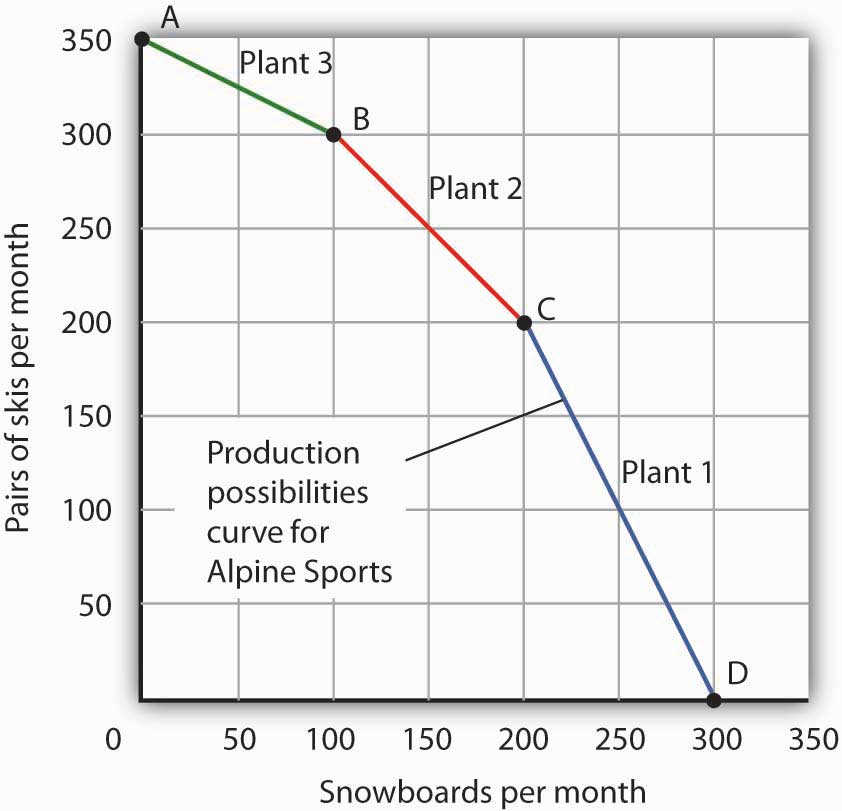
The bend shown combines the production possibilities curves for each plant. At point A, Tall Sports produces 350 pairs of skis per month and no snowboards. If the firm wishes to increase snowboard product, it will first apply Found 3, which has a comparative reward in snowboards.
Constitute 3's comparative advantage in snowboard product makes a crucial betoken about the nature of comparative advantage. Information technology need not imply that a detail found is especially good at an activity. In our example, all 3 plants are as adept at snowboard production. Plant 3, though, is the least efficient of the 3 in ski production. Alpine thus gives up fewer skis when it produces snowboards in Plant 3. Comparative advantage thus can stem from a lack of efficiency in the production of an culling practiced rather than a special proficiency in the production of the first good.
The combined product possibilities curve for the firm'due south three plants is shown in Effigy 2.5 "The Combined Production Possibilities Curve for Alpine Sports". Nosotros begin at point A, with all three plants producing only skis. Production totals 350 pairs of skis per month and nil snowboards. If the firm were to produce 100 snowboards at Found three, ski production would fall by 50 pairs per month (call back that the opportunity toll per snowboard at Plant 3 is half a pair of skis). That would bring ski production to 300 pairs, at point B. If Alpine Sports were to produce still more than snowboards in a single month, information technology would shift production to Plant ii, the facility with the adjacent-everyman opportunity cost. Producing 100 snowboards at Plant ii would leave Alpine Sports producing 200 snowboards and 200 pairs of skis per month, at indicate C. If the firm were to switch entirely to snowboard production, Institute 1 would be the last to switch because the cost of each snowboard at that place is two pairs of skis. With all three plants producing only snowboards, the firm is at point D on the combined product possibilities curve, producing 300 snowboards per calendar month and no skis.
Notice that this production possibilities curve, which is made up of linear segments from each assembly plant, has a bowed-out shape; the accented value of its slope increases as Alpine Sports produces more and more than snowboards. This is a consequence of transferring resources from the product of one good to another according to comparative advantage. We shall examine the significance of the bowed-out shape of the curve in the next section.
The Law of Increasing Opportunity Toll
We meet in Effigy 2.5 "The Combined Production Possibilities Curve for Tall Sports" that, showtime at point A and producing only skis, Tall Sports experiences higher and college opportunity costs equally information technology produces more snowboards. The fact that the opportunity cost of additional snowboards increases as the business firm produces more of them is a reflection of an of import economic law. The police of increasing opportunity cost holds that as an economic system moves forth its production possibilities curve in the direction of producing more of a detail good, the opportunity cost of boosted units of that adept volition increase.
Nosotros have seen the law of increasing opportunity toll at work traveling from point A toward point D on the production possibilities curve in Figure 2.5 "The Combined Production Possibilities Curve for Alpine Sports". The opportunity toll of each of the first 100 snowboards equals half a pair of skis; each of the adjacent 100 snowboards has an opportunity cost of ane pair of skis, and each of the final 100 snowboards has an opportunity toll of two pairs of skis. The police also applies as the business firm shifts from snowboards to skis. Suppose information technology begins at indicate D, producing 300 snowboards per calendar month and no skis. It can shift to ski production at a relatively depression cost at outset. The opportunity cost of the commencement 200 pairs of skis is just 100 snowboards at Plant 1, a move from point D to signal C, or 0.v snowboards per pair of skis. We would say that Plant 1 has a comparative reward in ski production. The adjacent 100 pairs of skis would be produced at Constitute two, where snowboard product would fall by 100 snowboards per calendar month. The opportunity price of skis at Found two is 1 snowboard per pair of skis. Plant 3 would be the terminal found converted to ski product. There, 50 pairs of skis could be produced per month at a cost of 100 snowboards, or an opportunity cost of 2 snowboards per pair of skis.
The bowed-out production possibilities bend for Tall Sports illustrates the constabulary of increasing opportunity cost. Scarcity implies that a production possibilities bend is downward sloping; the police of increasing opportunity cost implies that it will be bowed out, or concave, in shape.
The bowed-out curve of Figure ii.5 "The Combined Production Possibilities Curve for Alpine Sports" becomes smoother as nosotros include more production facilities. Suppose Tall Sports expands to x plants, each with a linear product possibilities bend. Panel (a) of Figure 2.vi "Production Possibilities for the Economy" shows the combined curve for the expanded house, synthetic equally we did in Effigy ii.5 "The Combined Product Possibilities Curve for Alpine Sports". This product possibilities bend includes 10 linear segments and is almost a smooth bend. As we include more and more production units, the curve will go smoother and smoother. In an actual economy, with a tremendous number of firms and workers, information technology is easy to encounter that the production possibilities curve will be smooth. Nosotros volition generally draw production possibilities curves for the economy equally smooth, bowed-out curves, like the one in Panel (b). This production possibilities curve shows an economy that produces only skis and snowboards. Discover the curve all the same has a bowed-out shape; it withal has a negative slope. Notice too that this curve has no numbers. Economists often utilize models such as the production possibilities model with graphs that show the general shapes of curves but that do not include specific numbers.
Effigy ii.half dozen Product Possibilities for the Economy

As we combine the product possibilities curves for more and more than units, the curve becomes smoother. It retains its negative slope and bowed-out shape. In Panel (a) we have a combined production possibilities curve for Alpine Sports, assuming that information technology now has x plants producing skis and snowboards. Even though each of the plants has a linear curve, combining them according to comparative advantage, as we did with 3 plants in Figure 2.5 "The Combined Product Possibilities Bend for Alpine Sports", produces what appears to be a smooth, nonlinear curve, even though it is made up of linear segments. In drawing production possibilities curves for the economic system, we shall more often than not assume they are smooth and "bowed out," as in Panel (b). This curve depicts an entire economy that produces only skis and snowboards.
Movements Along the Product Possibilities Curve
Nosotros can use the product possibilities model to examine choices in the production of goods and services. In applying the model, nosotros assume that the economy can produce two appurtenances, and we assume that engineering science and the factors of production bachelor to the economy remain unchanged. In this section, we shall assume that the economy operates on its production possibilities curve so that an increase in the product of one good in the model implies a reduction in the production of the other.
Nosotros shall consider two goods and services: national security and a category we shall phone call "all other goods and services." This second category includes the entire range of goods and services the economy can produce, aside from national defense and security. Clearly, the transfer of resources to the effort to enhance national security reduces the quantity of other goods and services that tin can be produced. In the wake of the 9/11 attacks in 2001, nations throughout the globe increased their spending for national security. This spending took a variety of forms. One, of class, was increased defence force spending. Local and country governments besides increased spending in an attempt to prevent terrorist attacks. Airports around the world hired additional agents to inspect luggage and passengers.
The increment in resources devoted to security meant fewer "other goods and services" could be produced. In terms of the production possibilities bend in Effigy 2.7 "Spending More for Security", the choice to produce more security and less of other goods and services ways a move from A to B. Of form, an economy cannot really produce security; it tin merely attempt to provide information technology. The attempt to provide it requires resources; it is in that sense that we shall speak of the economy every bit "producing" security.
Effigy two.7 Spending More for Security
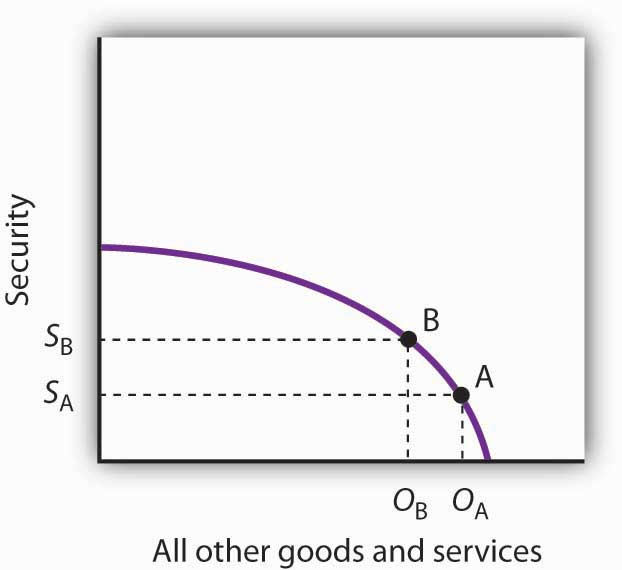
Here, an economy that can produce two categories of goods, security and "all other appurtenances and services," begins at bespeak A on its production possibilities bend. The economy produces S A units of security and O A units of all other goods and services per period. A movement from A to B requires shifting resources out of the production of all other goods and services and into spending on security. The increment in spending on security, to S A units of security per period, has an opportunity toll of reduced production of all other appurtenances and services. Production of all other appurtenances and services falls by O A – O B units per catamenia.
At indicate A, the economy was producing S A units of security on the vertical axis—defense services and diverse forms of police protection—and O A units of other goods and services on the horizontal centrality. The decision to devote more resources to security and less to other goods and services represents the choice we discussed in the affiliate introduction. In this instance we take categories of goods rather than specific goods. Thus, the economy chose to increment spending on security in the attempt to defeat terrorism. Since nosotros accept assumed that the economy has a fixed quantity of available resource, the increased use of resources for security and national defense necessarily reduces the number of resources available for the production of other goods and services.
The police force of increasing opportunity cost tells us that, every bit the economy moves along the production possibilities curve in the direction of more of one proficient, its opportunity cost will increase. We may conclude that, every bit the economic system moved forth this bend in the direction of greater production of security, the opportunity cost of the additional security began to increase. That is because the resources transferred from the production of other goods and services to the product of security had a greater and greater comparative advantage in producing things other than security.
The production possibilities model does not tell the states where on the bend a particular economic system will operate. Instead, information technology lays out the possibilities facing the economy. Many countries, for example, chose to move along their respective production possibilities curves to produce more security and national defense and less of all other goods in the wake of 9/11. We will come across in the chapter on demand and supply how choices near what to produce are made in the marketplace.
Producing on Versus Producing Inside the Production Possibilities Curve
An economy that is operating inside its production possibilities curve could, by moving onto it, produce more of all the goods and services that people value, such as food, housing, education, medical care, and music. Increasing the availability of these goods would improve the standard of living. Economists conclude that information technology is meliorate to exist on the production possibilities curve than within information technology.
2 things could exit an economic system operating at a indicate inside its production possibilities curve. First, the economy might fail to use fully the resources available to information technology. Second, information technology might not allocate resources on the ground of comparative advantage. In either case, production inside the product possibilities bend implies the economy could ameliorate its performance.
Idle Factors of Production
Suppose an economy fails to put all its factors of production to work. Some workers are without jobs, some buildings are without occupants, some fields are without crops. Considering an economy's product possibilities curve assumes the full use of the factors of production bachelor to it, the failure to use some factors results in a level of product that lies inside the production possibilities curve.
If all the factors of production that are available for utilise under electric current market conditions are existence utilized, the economy has achieved total employment. An economy cannot operate on its production possibilities curve unless information technology has full employment.
Figure 2.8 Idle Factors and Production
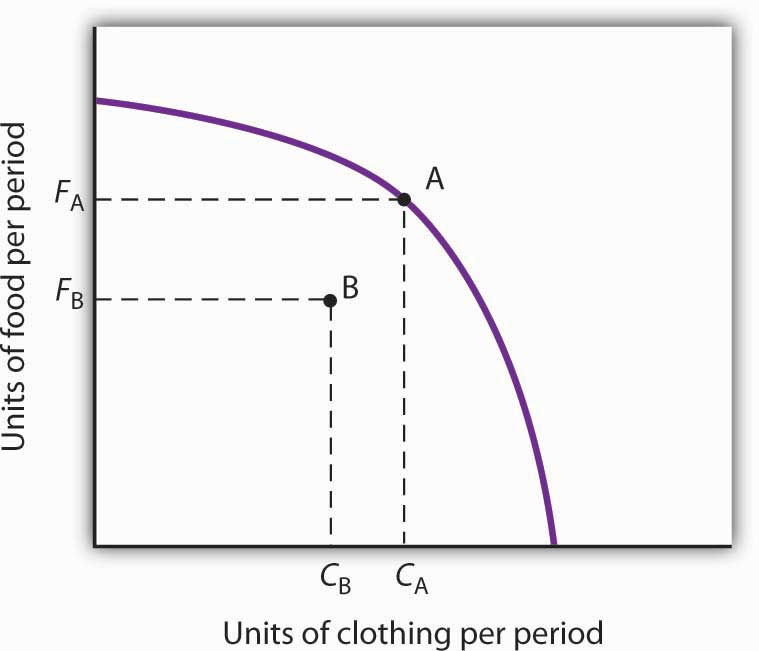
The production possibilities curve shown suggests an economic system that tin produce 2 goods, food and clothing. As a result of a failure to reach full employment, the economic system operates at a bespeak such as B, producing F B units of food and C B units of clothing per period. Putting its factors of production to work allows a motion to the production possibilities curve, to a signal such as A. The product of both goods rises.
Figure 2.8 "Idle Factors and Production" shows an economic system that can produce food and wearable. If information technology chooses to produce at signal A, for example, it can produce F A units of food and C A units of clothing. Now suppose that a big fraction of the economic system's workers lose their jobs, so the economy no longer makes full use of one factor of product: labor. In this instance, production moves to bespeak B, where the economic system produces less food (F B) and less clothing (C B) than at point A. We often call up of the loss of jobs in terms of the workers; they have lost a chance to work and to earn income. But the production possibilities model points to another loss: appurtenances and services the economy could have produced that are not being produced.
Inefficient Production
Now suppose Alpine Sports is fully employing its factors of product. Could information technology still operate inside its production possibilities curve? Could an economic system that is using all its factors of product still produce less than it could? The answer is "Yes," and the cardinal lies in comparative advantage. An economy achieves a point on its production possibilities curve but if it allocates its factors of production on the basis of comparative advantage. If it fails to practice that, it volition operate inside the curve.
Suppose that, as before, Alpine Sports has been producing merely skis. With all iii of its plants producing skis, it tin produce 350 pairs of skis per month (and no snowboards). The house and so starts producing snowboards. This time, still, imagine that Tall Sports switches plants from skis to snowboards in numerical order: Plant 1 first, Establish two second, and and then Found 3. Figure 2.9 "Efficient Versus Inefficient Production" illustrates the issue. Instead of the bowed-out production possibilities curve ABCD, we become a bowed-in bend, AB′C′D. Suppose that Alpine Sports is producing 100 snowboards and 150 pairs of skis at betoken B′. Had the firm based its production choices on comparative advantage, it would have switched Plant three to snowboards and and so Found ii, and so it could have operated at a point such as C. Information technology would be producing more than snowboards and more than pairs of skis—and using the same quantities of factors of production it was using at B′. Had the firm based its production choices on comparative advantage, information technology would take switched Found 3 to snowboards and and then Institute 2, so information technology would take operated at point C. Information technology would be producing more snowboards and more pairs of skis—and using the same quantities of factors of product information technology was using at B′. When an economy is operating on its production possibilities curve, we say that it is engaging in efficient production. If it is using the aforementioned quantities of factors of product but is operating inside its production possibilities curve, it is engaging in inefficient production. Inefficient production implies that the economy could be producing more than goods without using any additional labor, capital letter, or natural resources.
Figure 2.9 Efficient Versus Inefficient Production
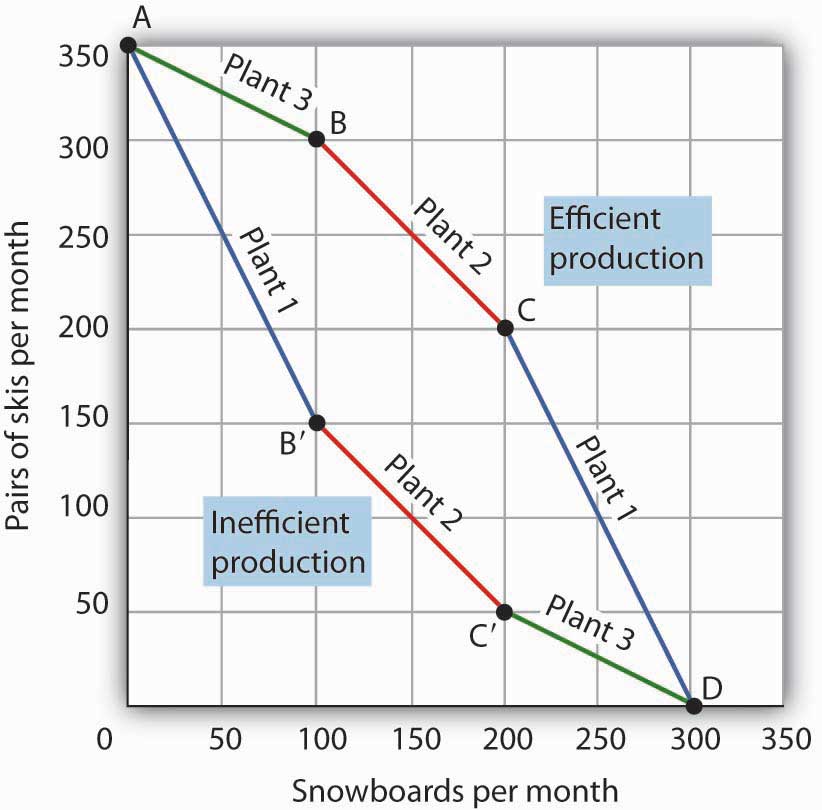
When factors of production are allocated on a basis other than comparative advantage, the result is inefficient production. Suppose Alpine Sports operates the iii plants we examined in Effigy ii.4 "Product Possibilities at Three Plants". Suppose further that all iii plants are devoted exclusively to ski production; the firm operates at A. Now suppose that, to increase snowboard production, it transfers plants in numerical order: Plant one showtime, so Plant 2, and finally Constitute iii. The result is the bowed-in curve AB′C′D. Production on the production possibilities curve ABCD requires that factors of product be transferred according to comparative reward.
Points on the production possibilities bend thus satisfy two conditions: the economic system is making full use of its factors of production, and information technology is making efficient use of its factors of production. If there are idle or inefficiently allocated factors of production, the economy will operate inside the production possibilities bend. Thus, the production possibilities curve not only shows what can be produced; it provides insight into how goods and services should exist produced. It suggests that to obtain efficiency in product, factors of product should be allocated on the ground of comparative advantage. Farther, the economic system must brand total use of its factors of production if it is to produce the goods and services it is capable of producing.
Specialization
The production possibilities model suggests that specialization will occur. Specialization implies that an economy is producing the goods and services in which it has a comparative advantage. If Alpine Sports selects signal C in Figure 2.nine "Efficient Versus Inefficient Production", for example, information technology will assign Plant ane exclusively to ski production and Plants 2 and 3 exclusively to snowboard product.
Such specialization is typical in an economic arrangement. Workers, for example, specialize in particular fields in which they have a comparative advantage. People work and use the income they earn to purchase—perhaps import—goods and services from people who accept a comparative advantage in doing other things. The issue is a far greater quantity of goods and services than would be available without this specialization.
Think about what life would exist like without specialization. Imagine that you are all of a sudden completely cutting off from the residue of the economy. You must produce everything you consume; you obtain zilch from anyone else. Would you be able to consume what y'all consume now? Clearly not. It is hard to imagine that most of usa could even survive in such a setting. The gains we reach through specialization are enormous.
Nations specialize as well. Much of the land in the United states has a comparative reward in agricultural production and is devoted to that action. Hong Kong, with its huge population and tiny endowment of country, allocates about none of its country to agricultural use; that option would be too costly. Its country is devoted largely to nonagricultural use.
Cardinal Takeaways
- A production possibilities curve shows the combinations of two appurtenances an economic system is capable of producing.
- The downward slope of the production possibilities curve is an implication of scarcity.
- The bowed-out shape of the production possibilities curve results from allocating resources based on comparative advantage. Such an allocation implies that the law of increasing opportunity price volition agree.
- An economy that fails to fill and efficient use of its factors of production will operate inside its production possibilities bend.
- Specialization ways that an economy is producing the appurtenances and services in which it has a comparative advantage.
Attempt It!
Suppose a manufacturing firm is equipped to produce radios or calculators. It has ii plants, Found R and Plant S, at which it tin produce these appurtenances. Given the labor and the capital available at both plants, it can produce the combinations of the two goods at the two plants shown.
| Output per twenty-four hour period, Plant Due south | ||
|---|---|---|
| Combination | Calculators | Radios |
| D | l | 0 |
| E | 25 | 50 |
| F | 0 | 100 |
Put calculators on the vertical centrality and radios on the horizontal axis. Draw the production possibilities curve for Plant R. On a separate graph, draw the production possibilities curve for Plant Southward. Which constitute has a comparative advantage in calculators? In radios? At present depict the combined curves for the 2 plants. Suppose the firm decides to produce 100 radios. Where will it produce them? How many calculators will information technology be able to produce? Where volition it produce the calculators?
Example in Point: The Price of the Groovy Depression
Figure 2.10
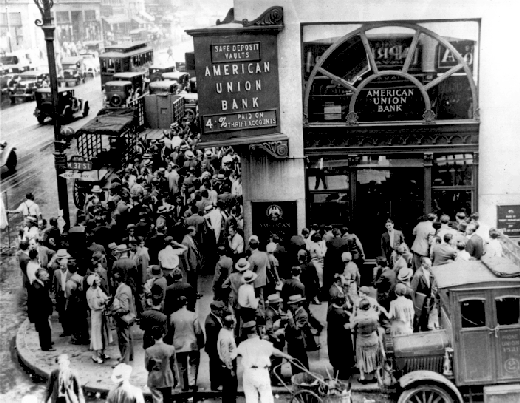
The U.S. economic system looked very healthy in the beginning of 1929. It had enjoyed seven years of dramatic growth and unprecedented prosperity. Its resources were fully employed; information technology was operating quite shut to its production possibilities curve.
In the summertime of 1929, however, things started going incorrect. Production and employment roughshod. They continued to fall for several years. Past 1933, more than 25% of the nation'southward workers had lost their jobs. Production had plummeted by virtually thirty%. The economic system had moved well within its production possibilities curve.
Output began to abound after 1933, just the economic system continued to have vast numbers of idle workers, idle factories, and idle farms. These resources were not put back to piece of work fully until 1942, after the U.S. entry into World State of war Ii demanded mobilization of the economic system's factors of production.
Betwixt 1929 and 1942, the economic system produced 25% fewer appurtenances and services than it would have if its resources had been fully employed. That was a loss, measured in today's dollars, of well over $iii trillion. In fabric terms, the forgone output represented a greater cost than the United States would ultimately spend in World State of war Ii. The Not bad Depression was a costly experience indeed.
Answer to Try It! Problem
The production possibilities curves for the two plants are shown, along with the combined curve for both plants. Plant R has a comparative advantage in producing calculators. Plant Southward has a comparative reward in producing radios, so, if the firm goes from producing 150 calculators and no radios to producing 100 radios, it volition produce them at Found Southward. In the production possibilities curve for both plants, the house would be at M, producing 100 calculators at Establish R.
Figure 2.11
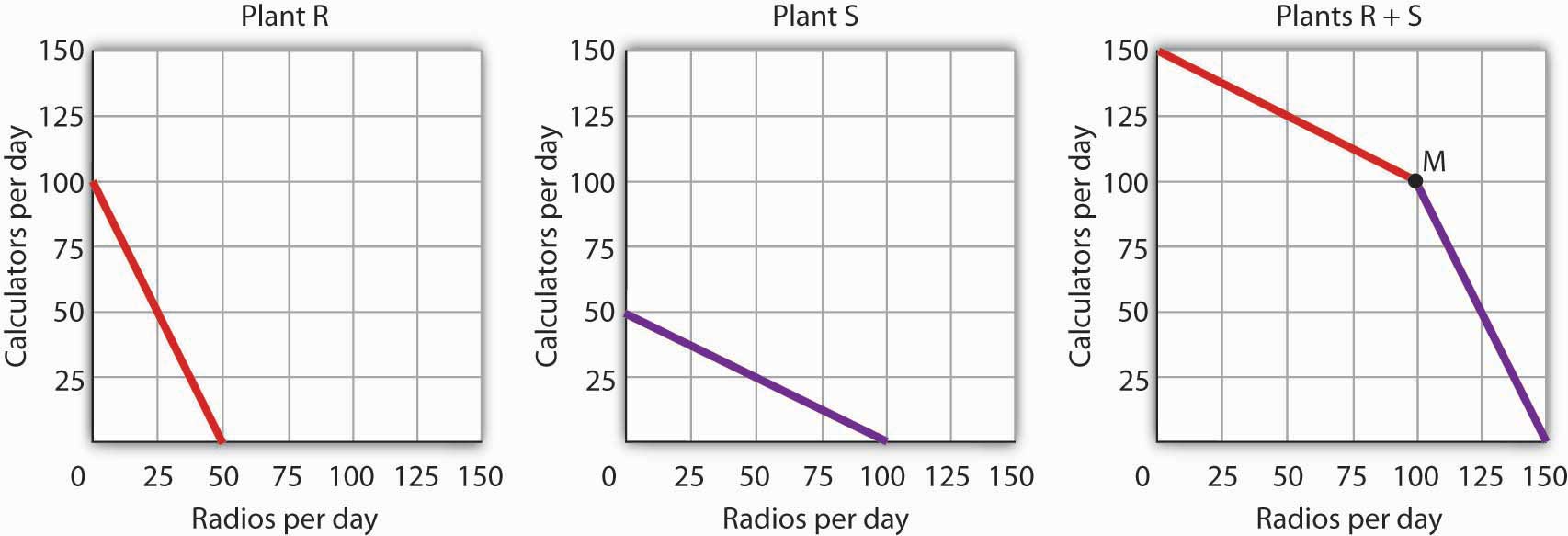
Source: https://open.lib.umn.edu/principleseconomics/chapter/2-2-the-production-possibilities-curve/
0 Response to "What Causes the Production Possibilities Curve to Shift Outward"
Post a Comment